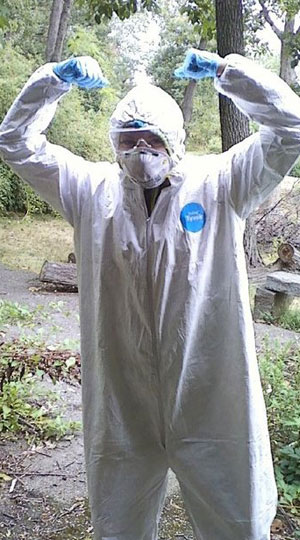Summers in the Past
A “Cliff Notes” Story
September 2012
It’s that time, the end of summer, when the sunlight starts to look a little different and the nights feel (one hopes) a little crisper than they have in weeks past. Each summer, our little staff at the Kearney House, some on college break, typically work together on a research, archiving, or preservation project that, in many cases, is long overdue. More staff means more hands to sift through old documents, man a copy machine, strap on a dust mask, or attempt to read tricky nineteenth-century penmanship. As some of our staff attempts to move on in the “real world,” we thought it would be fun to look back on some of our more recent projects.
For several summers, there were the correspondence books — carbon copies of letters sent by the Palisades Interstate Park Commission, for which those between 1907 and 1936 survive. These letters, bound together by year, include interoffice correspondence, admonishments for late rent written to folks living in old homes in the park (since torn down), replies to those who confused the Commission with the management of Palisades Amusement Park, and letters coordinating with organizations coming via boat or barge to our picnic groves along the river. The books of letters are kept with other Park Commission archives at Iona Island, just south of Bear Mountain. Venturing into the New York Section of the park often means that we return home with a story — including the trip to Iona Island where we found ourselves in a freight elevator, which led upstairs to a room filled with any and all materials one would need to furnish a certain Inn…
Back on Jersey soil, we scanned and digitized each and every letter that pertained to the New Jersey Section. Along with the letters that made us smile (“…the Palisades Interstate Park Commission owns no land in South America, nor has [any] operation on that continent”; or, “I cannot see that the Commissioners would have any use for your freak chicken”), there were letters that taught us something about the early days in the park. One letter read, “The Palisades Interstate Park is distinctly a park for all the people irrespective of nationality, color, or religion.” That letter was written in 1922 and brought us a different kind of smile.
Perhaps more infamous (to us, at least) than the correspondence books was last summer’s project. It all began with a small building at Allison Park in Englewood Cliffs that, by the looks of it, seemed like a cute cottage with a beautiful view. We were told that this building housed some of the business records and correspondences of William O. Allison, who had a large estate on the property and for whom Allison Park would be named. We were asked to go take a look and sift through the boxes. Upon our first visit, we unlocked the door and inside all we saw was maintenance equipment and a few mice — both living and dead. We explored and noticed an old wooden ladder leading up to the loft, which is where these papers were rumored to be. We made the climb up to get started on the project.
We were expecting a room full of cardboard boxes and maybe some furniture, but as we reached the loft, our eyes widened. The room was filled with papers, but not in the way that we had imagined. Documents and books were strewn across the floor, spilling out of ripped boxes, coated with rodent excrements, and eaten and torn to the point that much of it was indistinguishable from trash. There were also the locked file cabinets (Eric broke these open), a mangled baby carriage (?), a toilet, and other misfit items.
We had a long summer ahead of us. Armed with garbage bags, rubber gloves, and dust masks, we began to make order of the chaos. We ventured over to Allison Park about once a week and cleared the sweltering room, placing the salvageable papers into clean, new boxes. We eventually transferred most of the items to our Park Headquarters building. We knew that some of the papers were of value even beyond the park, while much of it represented day-to-day caretaker-type records that had no real use. We therefore invited librarians from Rutgers University to examine the “collection,” and they indeed took what was noteworthy from it. Of the remainder, we copied and digitized what we knew was relevant to the park’s history (and not ruined beyond repair), to add to our park history files. Hanging up our Tyvek suits, we realized it was another research adventure not soon to be forgotten.




